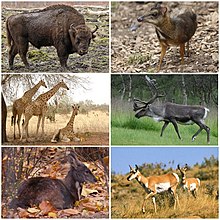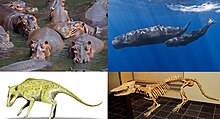Cetruminantia
Cetruminantia su klada koja obuhvata Cetancodontamorpha (ili Whippomorpha) i njihove najbliže srodnike, Ruminantia.[1]
| Cetruminantia Vremenski raspon: rani eocen do sadašnjosti
| |
|---|---|

| |

| |
| Naučna klasifikacija | |
| Domen: | Eukaryota |
| Carstvo: | Animalia |
| Tip: | Chordata |
| Klasa: | Mammalia |
| Red: | Artiodactyla |
| Kladus: | Artiofabula |
| Kladus: | Cetruminantia Waddell et al. 1999 |
| Podgrupe | |
Položaj Cetruminantia unutar Artiodactyla može se predstaviti na sledećem kladogramu:[2][3][4][5][6]
| Artiodactyla |
| ||||||||||||||||||||||||
Reference уреди
- ^ A higher-level MRP supertree of placental mammals
- ^ Beck, N.R. (2006). „A higher-level MRP supertree of placental mammals”. BMC Evol Biol. 6: 93. PMC 1654192 . PMID 17101039. doi:10.1186/1471-2148-6-93.
- ^ O'Leary, M.A.; Bloch, J.I.; Flynn, J.J.; Gaudin, T.J.; Giallombardo, A.; Giannini, N.P.; et al. (2013). „The placental mammal ancestor and the post-K-Pg radiation of placentals”. Science. 339 (6120): 662—667. PMID 23393258. S2CID 206544776. doi:10.1126/science.1229237. hdl:11336/7302 .
- ^ Song, S.; Liu, L.; Edwards, S.V.; Wu, S. (2012). „Resolving conflict in eutherian mammal phylogeny using phylogenomics and the multispecies coalescent model”. Proceedings of the National Academy of Sciences. 109 (37): 14942—14947. PMC 3443116 . PMID 22930817. doi:10.1073/pnas.1211733109 .
- ^ dos Reis, M.; Inoue, J.; Hasegawa, M.; Asher, R.J.; Donoghue, P.C.J.; Yang, Z. (2012). „Phylogenomic datasets provide both precision and accuracy in estimating the timescale of placental mammal phylogeny”. Proceedings of the Royal Society B: Biological Sciences. 279 (1742): 3491—3500. PMC 3396900 . PMID 22628470. doi:10.1098/rspb.2012.0683 .
- ^ Upham, N.S.; Esselstyn, J.A.; Jetz, W. (2019). „Inferring the mammal tree: Species-level sets of phylogenies for questions in ecology, evolution, and conservation”. PLoS Biology. 17 (12): e3000494. PMC 6892540 . PMID 31800571. doi:10.1371/journal.pbio.3000494 ; (see fig S10)